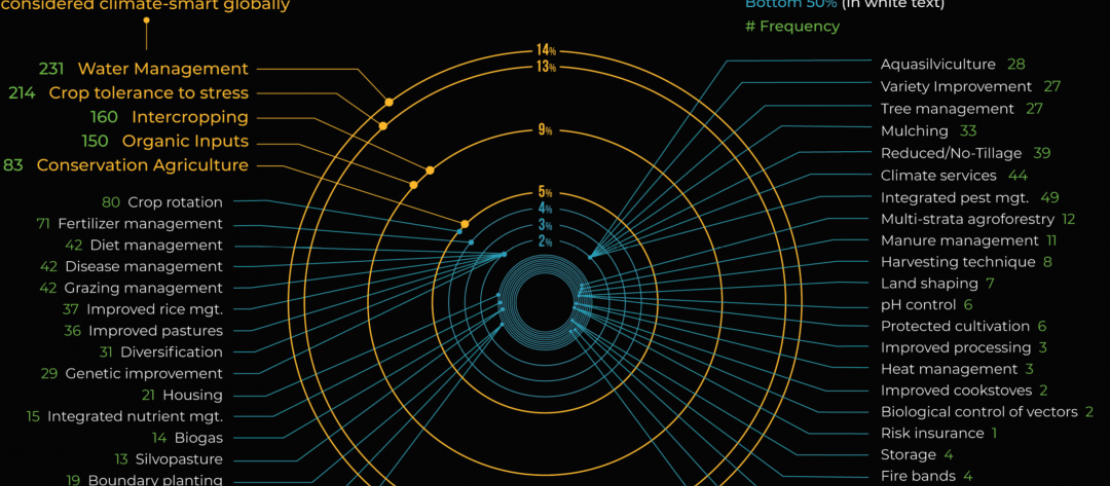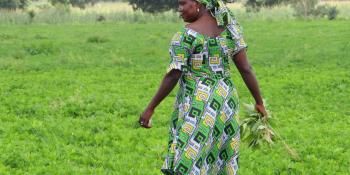World Bank launches global analysis of climate-smart agriculture in 33 countries

KATOWICE, POLAND (5th December) – A report launched by the CGIAR Research Program on Climate Change, Agriculture and Food Security (CCAFS), the International Center for Tropical Agriculture (CIAT) and the World Bank at COP24 analyzes efforts to transform farming with climate-smart agriculture (CSA) in 33 countries to guide future investment and build resilience for the world’s 500 million smallholder farmers vulnerable to climate change.
The report is the most comprehensive analysis of CSA to date, listing the top 10 insights into its implementation that scientists have gathered from countries in Africa, Asia and Latin America during five years of research.
“Across regions in the developing countries where we work, we see strongly growing demand for climate-smart food systems,” said Martien van Nieuwkoop, the Director of Agriculture for the World Bank Group. “One thing is clear from this synthesis: there are many opportunities to switch to practices that unlock the triple wins of higher yields, improved resilience and reduced greenhouse gas emissions, and more and more expertise is available to make this vision a reality.”
The CSA profile concept was designed to guide large-scale agricultural investments and seeks to provide a scientific framework to guide future CSA financing and de-risk investment in the sector. In the report, more than 1,500 experts across 33 countries categorize and rate the “smartness” of dozens of CSA interventions, as well as identifying key barriers to adoption and opportunities for scaling up.
Some 1,700 CSA combinations were evaluated in the report but just five technology clusters account for 50 per cent of all CSA technologies identified: water management, crop tolerance to stress, intercropping, organic fertilization and pest control, and conservation agriculture.
Other major findings of the report include:
- Technologies considered climate smart vary from region to region. The “smartest” techniques by region are silvopasture, intercropping and biogas harnessing in Latin America and the Caribbean, Africa and Asia, respectively.
- The implementation of CSA almost always leads to increase profitability on smallholder farms
- Most CSA techniques are “triple-win” scenarios; meaning they increase production, demonstrate adaptation to the effects of climate change and mitigation of agriculture’s climate impact. Five technology clusters were ranked in the top 10 for climate-smartness in all three clusters: tree management, improved pastures, silvopasture, conservation agriculture and water management
- Training and information for farmers were found to be the biggest obstacles to CSA adoption across all regions, affecting almost 90 percent of CSA interventions.
- There is no CSA silver bullet. Interventions need to be tailored to the individual plot.
The report found that silvopastoral farming and conservation agriculture are the top two systems in climate “smartness” globally.
The global CSA synthesis draws from 33 CSA Country Profiles created by scientists from CCAFS and CIAT since 2014 with the support of the World Bank, USAID, the United Kingdom, and national governments where the profiles were made.
“The CSA profiles are an effective entry point to unlock discussions and actions on CSA,” said Godefroy Grosjean, CIAT’s Asia Climate Policy Hub leader. “They should however be embedded within a broader suite of decision-making tools, such as Climate Smart Investments plans and sub-national climate risks profiles. These will allow actors to look beyond on-farm practices and develop strategies that increase resilience of the whole agricultural value chain, while reducing emissions and improving livelihoods. CCAFS, CIAT and partners such as the World Bank are particularly committed to provide support to decision-making to make the agricultural transformation a success.”
COP23 last year in Bonn, Germany, was the first time agriculture was identified as an implementation target in the UNFCCC’s 25-plus-year history.
The world’s hundreds of millions of smallholder farms stand the most to gain from CSA. They also hold major potential to contribute to mitigation targets, through the reduction of deforestation, livestock methane emissions and soil disturbance.
Climate factors combined with population growth, changing diets, rapid urbanization and other global trends “will result in farmers, pastoralists, and fishers everywhere facing unprecedented challenges in feeding themselves and the world,” notes the report. CSA may still be in its early days but adoption levels are steadily increasing and accelerating across regions, according to the report’s experts.
Click here to access the report: http://bit.ly/csa_profiles_report
The CGIAR Research Program on Climate Change, Agriculture and Food Security (CCAFS) brings together some of the world’s best researchers in agricultural science, development research, climate science and Earth system science, to identify and address the most important interactions, synergies and tradeoffs between climate change, agriculture and food security. Visit us online at https://ccafs.cgiar.org.
The International Center for Tropical Agriculture (CIAT) is a CGIAR research center. CIAT develops technologies, innovative methods and knowledge that enable farmers, especially smallholders, to make agriculture more competitive, profitable, sustainable and resilient. Headquartered in Cali, Colombia, CIAT conducts research for development in tropical regions of Latin America, Africa, and Asia. https://ciat.cgiar.org
The World Bank works with low and middle-income countries and partners to provide innovation and resources so that the food system lifts people out of poverty, produces safe and nutritious food for everyone, and is more sustainable and resilient in the face of resource constraints and climate change. Learn more: www.worldbank.org/agriculture.


